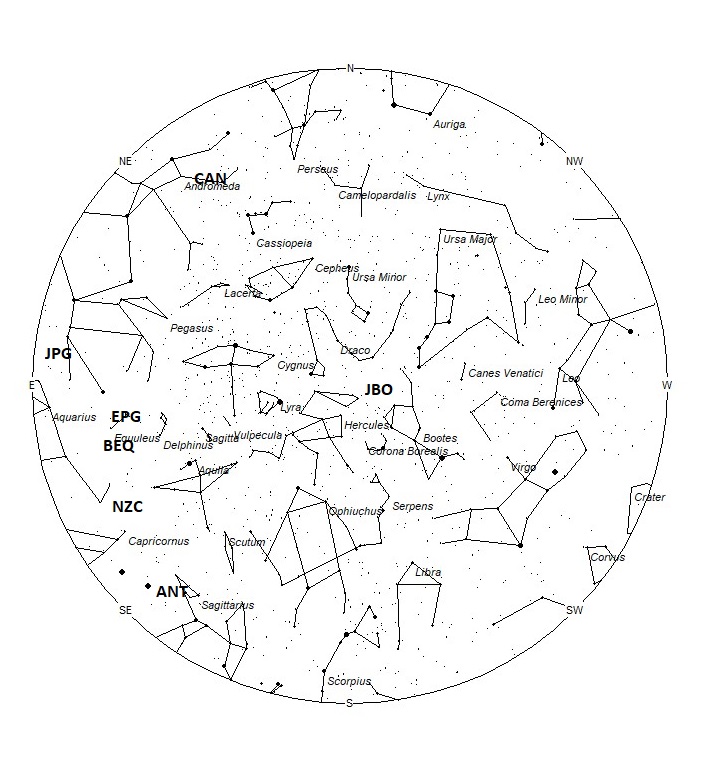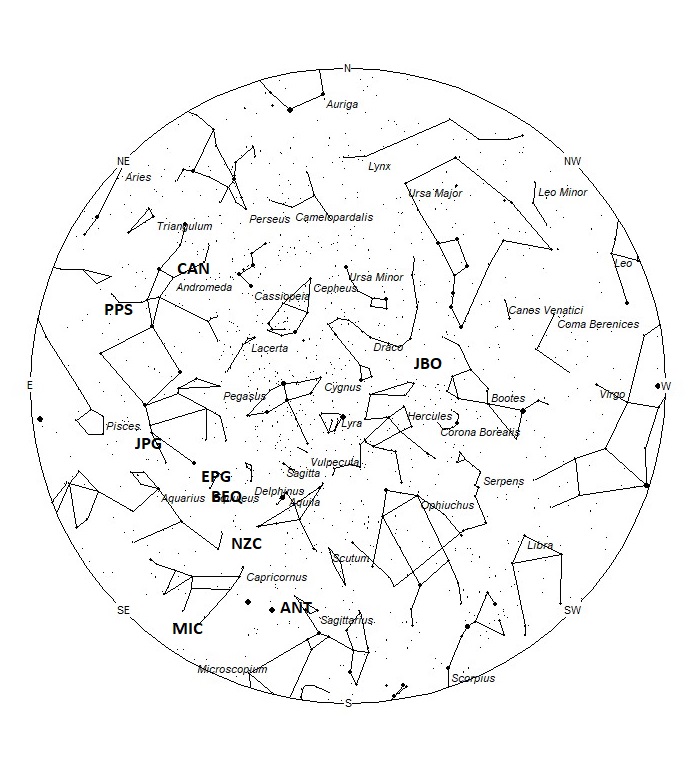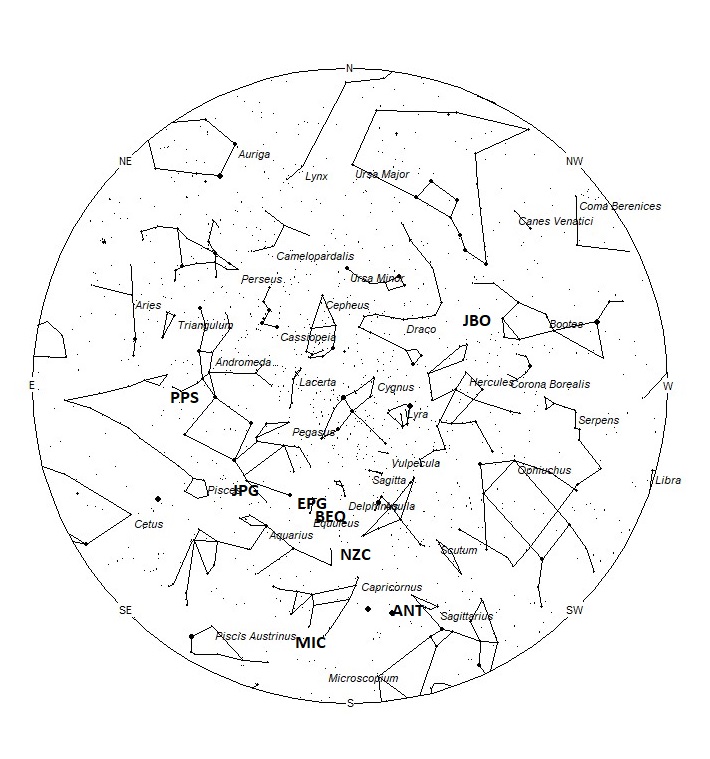Meteor season finally gets going in July for the northern hemisphere. The first half of the month will be much like June with predominately slow rates. After the 15th though, both sporadic and shower rates increase significantly. For observers in the southern hemisphere, sporadic rates will be falling but the overall activity will increase with the arrival of the Southern delta Aquariids during the last week of the month.
During this period, the moon reaches its first quarter phase on Sunday June 28th. At this time, the moon is located 90 degrees east of the sun and sets near 01:00 local summer time (LST). As the week progresses the waxing gibbous moon remains longer in the morning sky with each passing night. This narrows the opportunity to view meteor activity under dark conditions from many hours early in the period to almost nil late in the period. The estimated total hourly meteor rates for evening observers this week is near 2 for those viewing from the northern hemisphere and 3 for those located south of the equator. For morning observers, the estimated total hourly rates should be near 14 as seen from mid-northern latitudes (45N) and 17 as seen from tropical southern locations (25S). The actual rates will also depend on factors such as personal light and motion perception, local weather conditions, alertness, and experience in watching meteor activity. Evening rates are reduced during this period due to moonlight. Note that the hourly rates listed below are estimates as viewed from dark sky sites away from urban light sources. Observers viewing from urban areas will see less activity as only the brighter meteors will be visible from such locations.
The radiant (the area of the sky where meteors appear to shoot from) positions and rates listed below are exact for Saturday night/Sunday morning June 27/28. These positions do not change greatly day to day so the listed coordinates may be used during this entire period. Most star atlases (available at science stores and planetariums) will provide maps with grid lines of the celestial coordinates so that you may find out exactly where these positions are located in the sky. A planisphere or computer planetarium program is also useful in showing the sky at any time of night on any date of the year. Activity from each radiant is best seen when it is positioned highest in the sky, either due north or south along the meridian, depending on your latitude. It must be remembered that meteor activity is rarely seen at the radiant position. Rather they shoot outwards from the radiant, so it is best to center your field of view so that the radiant lies at the edge and not the center. Viewing there will allow you to easily trace the path of each meteor back to the radiant (if it is a shower member) or in another direction if it is a sporadic. Meteor activity is not seen from radiants that are located far below the horizon. The positions below are listed in a west to east manner in order of right ascension (celestial longitude). The positions listed first are located further west therefore are accessible earlier in the night while those listed further down the list rise later in the night.
These sources of meteoric activity are expected to be active this week.
.
The last of the June Bootids (JBO) are expected during this period. These meteors are best seen from June 25-29 with maximum activity occurring on the 27th. At maximum the radiant is located at 14:48 (223) +48. This position lies in northwestern Bootes, 15 degrees east of the 2nd magnitude star known as Alkaid (Eta Ursae Majoris). This radiant is best placed in the evening sky just as the sky becomes dark. Observers in the northern hemisphere have a distinct advantage over those located south of the equator as the radiant lies much higher in the evening sky. No matter your location, little activity is expected from this source. With an entry velocity of 14 km/sec., the average June Bootid meteor would be of very slow velocity.
The center of the large Anthelion (ANT) radiant is currently located at 19:16 (289) -23. This position lies in northeastern Sagittarius, 2 degrees southeast of the 3rd magnitude star known as Albaldah (pi Sagittarii). Due to the large size of this radiant, Anthelion activity may also appear from western Capricornus as well as Sagittarius. This radiant is best placed near 0200 LST, when it lies on the meridian and is located highest in the sky. Rates at this time should be near 2 per hour as seen from mid-northern latitudes (45 N) and 3 per hour as seen from the southern tropics (S 25). With an entry velocity of 30 km/sec., the average Anthelion meteor would be of slow velocity.
The Northern June Aquilids (NZC) were discovered by Zdenek Sekanina in 1976. These meteors are active from a radiant located at 20:20 (305) -07. This area of the sky is located in southern Aquila, 5 degrees north of the 4th magnitude star known as Algedi (α² Capricorni). This radiant is best placed near 0300 LST, when it lies on the meridian and is located highest in the sky. Hourly rates at this time should be near 2 no matter your location. With an entry velocity of 38 km/sec., the average meteor from this source would be of medium-slow velocity. An interesting fact about this source is that it may be related to the Northern delta Aquariids of August. Where and when this source ends coincides with the start and position of the Northern delta Aquariids.
The Microscopiids (MIC) were discovered by G. Gartrell and W. G. Elford, in their study of Southern Hemisphere meteor streams. This stream is active from June 9 through July 17 with maximum activity occurring on July 5. The radiant is currently located at 20:44 (311) -30. This area of the sky is located in northern Microscopium, 4 degrees southwest of the 4th magnitude star known as omega Capricornii. This radiant is best placed near 0300 LST, when it lies on the meridian and is located highest in the sky. Hourly rates at this time should be near 1 as seen from the southern hemisphere and less than 1 as seen from north of the equator. With an entry velocity of 39 km/sec., the average meteor from this source would be of medium-slow velocity. This shower is synonymous with the Southern June Aquilids (SZC).
The last of the beta Equulids (BEQ) are expected this weekend. These meteors are active from June 7-30 with maximum activity occurring on June 14th. The radiant position currently lies at 20:55 (314) +03. This area of the sky lies on the Delphinus/Equuleus border, just southwest of the faint star known as epsilon Equulei. This radiant is best placed near 0400 LST, when it lies on the meridian and is located highest in the sky. Hourly rates are expected to be less than 1, no matter your location. With an entry velocity of 33 kilometers per second, a majority of these meteors will appear to move with medium-slow velocities. Being discovered by radar, these meteors may be faint and difficult to observe by visual observing.
The epsilon Pegasids (EPG) were discovered by Dr. Peter Brown and associates using data from the Canadian Meteor Orbit Radar (CMOR) installation. These meteors are active from July 03-23 with maximum activity occurring on July 11th. The radiant position currently lies at 21:16 (319) +09. This area of the sky lies in eastern Equuleus, only 1 degree south of the 4th magnitude star known as delta Equulei. These meteors are best seen near 0400 LST when the radiant lies highest in the sky. Hourly rates are expected to be less than 1 no matter your location. With an entry velocity of 28 kilometers per second, a majority of these meteors will appear to move with medium-slow velocities.
The July Pegasids (JPE) are active from June 28 through August 15th. Maximum activity occurs on July 10th. The radiant is currently located at 22:32 (338) +08. This area of the sky is located in southwestern Pegasus, 3 degrees southwest of the 3rd magnitude star known as Homan (zeta Pegasi). This radiant is best placed near 0500 LST, when it lies on the meridian and is located highest in the sky. Rates are expected to be less 1 per hour this week no matter your location. With an entry velocity of 68 km/sec., the average meteor from this source would be of swift velocity.
The phi Piscids (PPS) were discovered by Dr. Peter Brown and associates using data from the Canadian Meteor Orbit Radar (CMOR) installation. These meteors are active from June 8-August 02 with maximum activity occurring on July 4th. The radiant position currently lies at 00:46 (011) +23. This area of the sky lies in southern Andromeda, 2 degrees west of the 4th magnitude star known as eta Andromedae. These meteors are best seen near during the last dark hour of the night when the radiant lies highest in a dark sky. Hourly rates are expected to be near 2 as seen from the northern hemisphere and 1 as seen from south of the equator. With an entry velocity of 67 kilometers per second, a majority of these meteors will appear to move with swift velocities.
The c-Andromedids (CAN) were discovered by Sirko Molau and Juergen Rendtel using video data from the IMO network. Activity from this source is seen from June 26 through July 27 with maximum activity occurring on July 9. The radiant currently lies at 01:04 (016) +44, which places it in northern Andromeda, 4 degrees south of the 4th magnitude star known as phi Andromedae. This area of the sky is best seen during the last dark hour before dawn when the radiant lies highest in a dark sky. Observers in the northern hemisphere are better situated to view this activity as the radiant rises much higher in the sky before dawn compared to southern latitudes. Current rates would be less than 1 per hour no matter your location. With an entry velocity of 58 km/sec., the average meteor from this source would be of swift velocity.
As seen from the mid-northern hemisphere (45N) one would expect to see approximately 7 sporadic meteors per hour during the last hour before dawn as seen from rural observing sites. Evening rates would be near 1 per hour. As seen from the tropical southern latitudes (25S), morning rates would be near 9 per hour as seen from rural observing sites and 2 per hour during the evening hours. Locations between these two extremes would see activity between the listed figures. Evening rates are reduced during this period due to moonlight.
The list below offers the information from above in tabular form. Rates and positions are exact for Saturday night/Sunday morning except where noted in the shower descriptions.
| SHOWER | DATE OF MAXIMUM ACTIVITY | CURRENT CELESTIAL POSITION | ENTRY VELOCITY | CULMINATION | HOURLY RATE | CLASS |
| RA (RA in Deg.) DEC | Km/Sec | Local Summer Time | North-South | |||
| June Bootids (JBO) | Jun 27 | 14:48 (223) +48 | 30 | 22:00 | <1 – <1 | III |
| Anthelion (ANT) | – | 19:16 (289) -23 | 30 | 02:00 | 2 – 3 | II |
| Northern June Aquilids (NZC) | Jul 02 | 20:20 (305) -07 | 41 | 03:00 | 2 – 2 | IV |
| Microscopiids (MIC) | Jul 05 | 20:44 (311) -30 | 39 | 03:00 | 1 – 2 | IV |
| beta Equulids (BEQ) | Jun 14 | 20:55 (314) +03 | 33 | 04:00 | <1 – <1 | IV |
| epsilon Pegasids (EPG) | Jul 04 | 21:16 (319) +09 | 28 | 04:00 | <1 – <1 | IV |
| July Pegasids (JPE) | Jul 10 | 22:32 (338) +08 | 68 | 05:00 | <1 – <1 | IV |
| phi Piscids (PPS) | Jul 04 | 00:46 (011) +23 | 67 | 07:00 | 2 – 1 | IV |
| c-Andromedids (CAN) | Jul 09 | 01:04 (016) +44 | 58 | 08:00 | <1 – <1 | IV |




